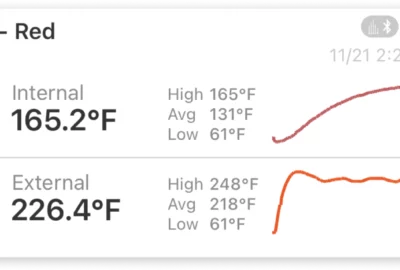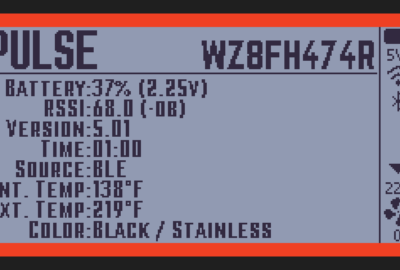Using your FireBoard
How to Smoke Pork on a Kettle Grill
Slow-cooked barbecue is as delicious as it is slow. It almost seems the longer it takes the better it tastes! But what if you wanted to have a pulled pork sandwich for lunch, tomorrow? Check below and we will show you how we did it with our trusty FireBoard Drive-enabled kettle grill that Paul found on Marketplace for $25.

A Seven-pound pork shoulder with rub liberally applied and ready for the smoker.
Why not Re-Heat?
Much like being a pick-up truck owner, when you start smoking meat, word travels fast, and people will be inviting you to all sorts of events, assuming you’re bringing some BBQ! The timing of long smoke sessions like a shoulder or brisket can be tricky when trying to have food ready at a designated time. Even for experienced smokers, the potential for ruining your niece’s birthday party is too much and many will opt for smoking a day or two in advance, to provide a margin for error. And why not? Many restaurants do it, visit our blog about HACCP plans to see how a KC BBQ chain supplies multiple locations with one smoker. As an additional side note do be aware of the pitfalls of reheating food and be aware of the Danger Zone and best practices to avoid making your friends and family sick. It’s a common practice in the restaurant world and is an option. Instant read thermometers like the Spark are great for spot-checking reheats before serving and are common professional tools.
Overview
The overlying tip in having something ready for lunchtime requires a long slow overnight cook at about 185ºF with some time the next morning wrapped up at 300ºF. The overnight cook is where the FireBoard really gives you peace of mind. The app allows you to set alerts if you have doubts about your fire burning out.

The graph of our cook from the FireBoard App, click here for shared view. The pork went on at 6:00 p.m. with a Drive set temp of 185ºF. At 8:00 a.m. we added some more charcoal to the Weber Kettle and wrapped the pork in foil, cooking it for an additional 2.5 hours at 300ºF.
So sleep well, if anything goes not as planned you will be able to step in and save your cook. The next morning, your meat will be nearing a stall, where the internal temperature of the meat slows down. You could definitely continue slow and low at 185ºF and the internal temp will eventually come up to 200ºF. But what we recommend is to apply a second seasoning (more on this later) and put it back on at 300ºF wrapped in foil. This way reaching the end goal of 200ºF will take only a few more hours. Also, this is a perfect time to add some charcoal if you are running low. Nothing will save you more precious free time than a FireBoard 2 Drive setup. Check out this post for more info on turning an old kettle into a Cloud Connected smoker.
Prep

Our Kettle was set up with a FireBoard Drive fan and an aluminum pan to keep the briquettes off to one side for a smoking session that would last over 12 hours. Don’t forget to add some wood chunks for the actual smoke flavor. We chose a 70/30 mixture of hickory to apple.
At about 5:00 p.m. we packed up a starter chimney of briquettes. This would give us about an hour to get the rub on the seven-pound pork shoulder and get the Kettle’s firebox set up for an overnight smoke. Since Weber’s accessory Char Basket has a relatively small volume, we used an aluminum pan to displace the briquettes off to one side of the grill. The pit started hot but came down eventually giving us a start time of about 6:00 p.m.

A pork butt just before an overnight smoking session at 185ºF.
Cook

Bark on the surface of the pork butt is rub that has caramelized after 14 hours of smoking and is a delicious treat.
The next morning we gradually started bumping the pit temp using the FireBoard App, over twenty miles away. We increased it up once at 6:30 to 200ºF and then again an hour later to 225ºF. We did this to get the pork to finish a little faster.
At 8:00 a.m. we pulled the butt off of the grill. Overnight the rub had caramelized and created a wonderful bark on the surface of the pork shoulder. Generous amounts of brown sugar and honey were added along with a vinegar-rich sauce, Blues Hog’s Tennessee Red. Cooking this wrapped up in two layers of foil braized this pork. This ensures a tender finished product while cooking at the higher 300ºF.

While wrapping the pork, don’t forget to check your coal status. This is the ideal time to replenish your fire.
Serve

The end product was very tender. The bone of the pork shoulder slid out smoothly, and the shredding was an easy task by hand.
After almost two and a half hours at 300ºF, the internal temperature of the butt reached 200ºF and was ready to serve. If you reach this point a little early, then putting the pork into a cooler will keep the warm with no concerns of overcooking. This is also a great way of transporting your creation.

Nothing will save you more precious free time than a FireBoard 2 Drive setup. Check out this post for more info on turning an old kettle into a Cloud Connected smoker.









Leave a reply